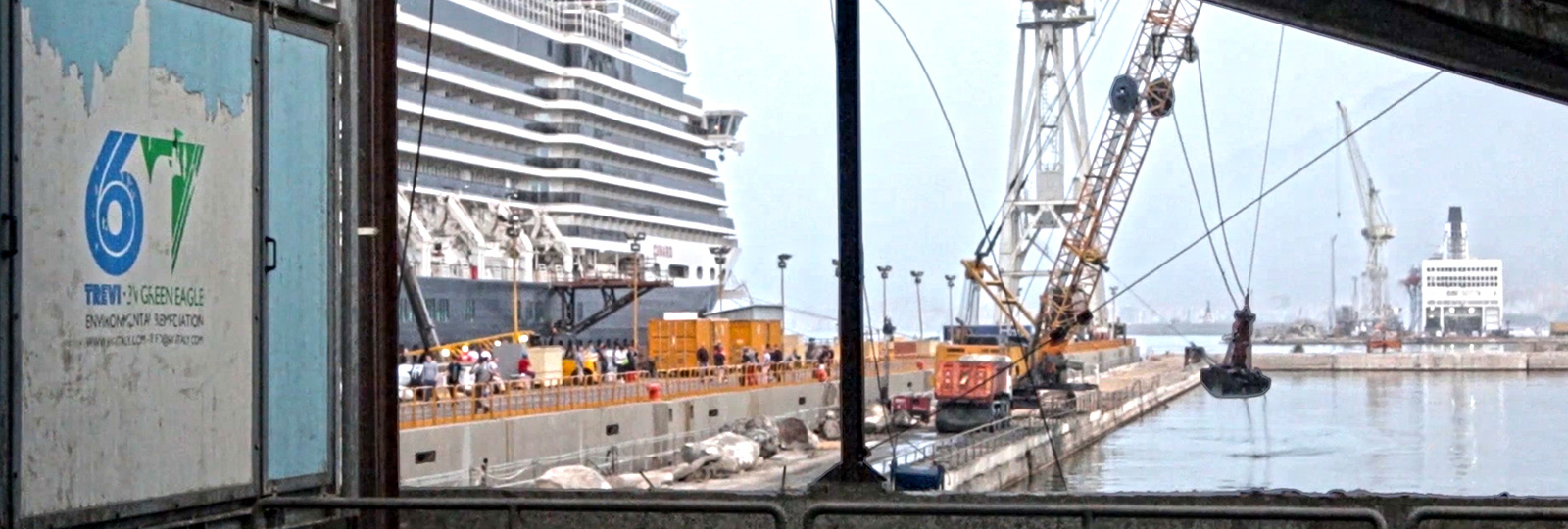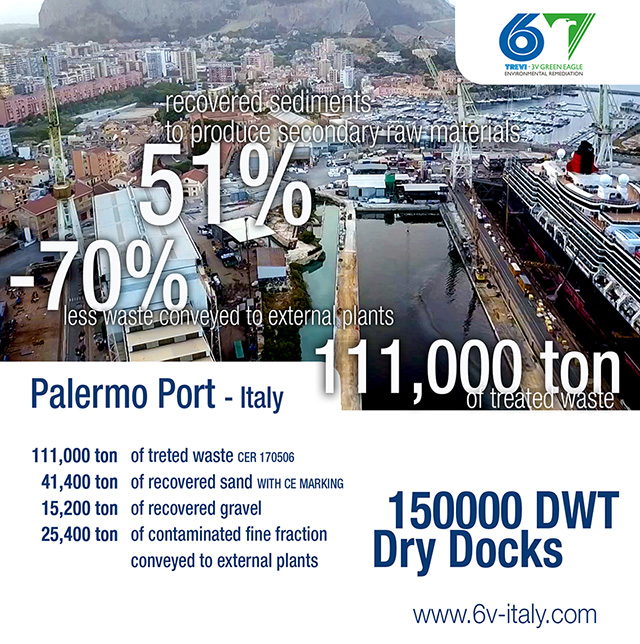6V (a collaboration between Trevi and 3V Green Eagle) completed its project of Sediment Washing (SW) for the Palermo Port Authority at the 150,000 DWT Dry Dock.
Trevi Plant is made up of five technological units which were specifically devised to carry out the whole waste management process.
The plant consists of different treatment Units:
• Unit A – feeding: it receives the accumulated shovelable wastes (at the bay) and properly conveys them to the plant, eliminating what may impair the plant’s proper functioning by means of a feed hopper equipped with protections, harrows and sensors for detection and removal of magnetic and non-magnetic ferrous materials.
• Unit B – washing and granulometric separation. Through this unit contaminants are transferred from the waste’s solid matrix to the washing fluid (fresh water or sea water) and contaminated fractions are separated from the recoverable ones. The first washing phase is carried out in the drum washing barrel, followed by the wet sieving of coarse materials and a sand refinement process by means of 6 attrition cells.
• Unit C – chemical-physical treatment of the residual suspension. This unit carries out coagulation and flocculation of suspended solids and their subsequent sedimentation, as well as separation of soluted contaminants through chemical conditioning.
• Unit D – Densification of the fine fraction. Muds concentrated in the chemical-physical treatment, collecting most of contaminants, are further dehydrated through solid/liquid separation devices. The main objective of mud treatment is to minimize the costs for final disposal. The plant, according to specific site needs, is equipped with two different systems of mechanical dehydration (decanter centrifuge or filter press). Only in some specific cases, i.e. when the suspension flow is quite high, both units are used simultaneously.
• Unit E – filtration and water cleaning finishing. Waste slurry is conditioned with acid to adjust the pH value. Eventually, filtration is carried out; first on sand beds (corindone/quarzite) to remove any possible solids and suspended pollutants and, finally, on an active coal bed to remove any dissolved pollutants. At last, wastewater is disinfected and discharged.
The plant has a variable output, mainly according to the granulometric features of the waste to be treated, especially in terms of fine fraction percentages (Φ < 0.063 mm). In fact, these fine fractions are separated from the turbid suspension, dehydrated by means of filter presses or centrifuges, which are devices whose productivity/costs ratio is very low. The largest granulometric sections are separated by means of screens and cyclones, which are highly productive. In this specific case, the features of sediments to be treated allow a maximum productivity equal to 60 tons/hour. The objective of the SW treatment is the recycling of materials and subsequent reduction of waste to be disposed of.
This technology, if properly applied, always reduces the amount of waste to be recycled/disposed of in external plants; for that reason it can be considered environmentally sustainable and developed in compliance with waste management regulations (Art. 179 of D.Lgs. 152/2006). The plant is recovering material – R5 “Recycling/recovery of other inorganic substances” – from the waste’s sandy and gravelly fraction (Φ > 0.063 mm), according to previously designed specific purposes. After undergoing a compliance audit at the jobsite, the sand achieves CE certification as recycled aggregate satisfying the technical requirements for the specific purposes, regulations and existing standards applied to products.
The separated and densified fine fraction and the other waste are recycled or disposed of in specifically authorized external plants, while waste slurry is cleaned up in a specific section of the SW plant and is eventually discharged into surface waters (according to Tab.3 Part 3, Attachment 5 of D.Lgs. 152/2006). Once the works were finished, approximately 111.000 tons of waste were treated, recovering 41.400 tons of sand, 15.200 tons of gravel, while 25.400 tons of contaminated fine fraction were disposed of in an external plant.
 English
English
 Italiano
Italiano  Español
Español 
